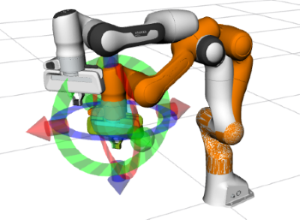An Abductive Reasoning Approach for Energy Saving in Robotic Systems
DOI:
https://doi.org/10.46604/emsi.2024.14475Keywords:
Abductive reasoning, industrial robot, cycle time, energy savingAbstract
The velocity and acceleration commands of industrial robots are set to their maximum values to shorten the cycle time of products. However, the excessively high speed and acceleration for movements can cause unnecessary mechanical energy and electricity consumption. This paper proposes an energy-saving approach for robotic systems based on abductive reasoning. Results for different combinations of speed commands and acceleration commands are evaluated based on energy consumption and cycle time. Moreover, a well-designed abduction rule formula is used to achieve a good balance between cycle time and mechanical energy consumption of industrial robots. Simulation results of a Franka robot by ROS, Gazebo, and Moveit verify the effectiveness of the proposed approach.
References
N. Barnett, D. Costenaro, and I. Rohmund, “Direct and Indirect Impacts of Robots on Future Electricity Load,” 2017 ACEEE Summer Study on Energy Efficiency in Industry, pp. 2-1–2-9, 2017.
M. Soori, B. Arezoo, and R. Dastres, “Optimization of Energy Consumption in Industrial Robots, a Review,” Cognitive Robotics, vol. 3, pp. 142-157, 2023.
R. Benotsmane and G. Kovács, “Optimization of Energy Consumption of Industrial Robots Using Classical PID and MPC Controllers,” Energies, vol. 16, no. 8, article no. 3499, 2023.
B. Liu, X. Yang, and J. Zhang, “Nonlinear Effect of Industrial Robot Applications on Carbon Emissions: Evidence from China,” Environmental Impact Assessment Review, vol. 104, article no. 107297, 2024.
F. Luan, X. Yang, Y. Chen, and P. Regis, “Industrial Robots and Air Environment: A Moderated Mediation Model of Population Density and Energy Consumption,” Sustainable Production and Consumption, vol. 30, pp. 870-888, 2022.
A. Agnetis and D. Pacciarelli “Part Sequencing in Three-Machine No-Wait Robotic Cells,” Operations Research Letters, vol. 27, no. 4, pp. 185-192, 2000.
W. Hurst and Y. Mostofi, “Optimization of Mobile Robotic Relay Operation for Minimal Average Wait Time,” IEEE Transactions on Wireless Communications, vol. 22, no. 6, pp. 3733-3747, 2022.
R. Thangaraj and T. R. Chelliah, “Evolutionary Algorithm Based In-Situ Efficiency Determination on Induction Motors for the Implementation of Energy Conservation Schemes,” Proceedings of 2015 IEEE 11th International Conference on Power Electronics and Drive Systems, IEEE Press, pp. 363-366, 2015.
P. Jiang, J. Zheng, Z. Wang, Y. Qin, and X. Li, “Industrial Robot Energy Consumption Model Identification: A Coupling Model-Driven and Data-Driven Paradigm,” Expert Systems with Applications, vol. 262, article no. 125604, 2025.
Z. Wang, P. Jiang, X. Li, Y. He, X. V. Wang and X. Yang, “A Novel Hybrid LSTM and Masked Multi-Head Attention Based Network for Energy Consumption Prediction of Industrial Robots,” Applied Energy, vol. 383, no. C, article no. 125223, 2025.
K. T. Fann, Peirce’s Theory of Abduction, Springer Science & Business Media, 2012.
G. Minnameier, “Forms of Abduction and an Inferential Taxonomy,” Springer Handbook of Model-Based Science, pp. 175-195, 2017.
N. Inoue and K. Inui, “ILP-Based Reasoning for Weighted Abduction,” Proceedings of the 16th AAAI Conference on Plan, Activity, and Intent Recognition, pp. 25-32, 2011.
J. R. Hobbs, M. E. Stickel, D. E. Appelt, and P. Martin, “Interpretation as Abduction,” Artificial Intelligence, vol. 63, no. 1-2, pp. 69-142, 1993.
K. Yamamoto, T. Onishi, and Y. Tsuruoka, “Hierarchical Reinforcement Learning with Abductive Planning,” https://arxiv.org/abs/1806.10792, 2018.
M. ElHayani, “RLAR: A Reinforcement Learning Abductive Reasoner,” Proceedings of the 16th International Conference on Agents and Artificial Intelligence (ICAART 2024), Science and Technology Publications, Lda., vol. 3, pp. 972-979, 2024.
T. Finin and G. Morris, “Abductive Reasoning in Multiple Fault Diagnosis,” Artificial Intelligence Review, vol. 3, pp. 129-158, 1989.
P. Schüller, “Modeling Variations of First-Order Horn Abduction in Answer Set Programming,” Fundamenta Informaticae, vol. 149, no. 1-2, pp. 159-207, 2016.

Downloads
Published
How to Cite
Issue
Section
License
Copyright (c) 2025 Ju-Feng Wu, Ming-Yang Cheng

This work is licensed under a Creative Commons Attribution-NonCommercial 4.0 International License.
Copyright Notice
Submission of a manuscript implies: that the work described has not been published before that it is not under consideration for publication elsewhere; that if and when the manuscript is accepted for publication. Authors can retain copyright in their articles with no restrictions. Also, author can post the final, peer-reviewed manuscript version (postprint) to any repository or website.
Since Sep. 01, 2023, EMSI will publish new articles with Creative Commons Attribution Non-Commercial License, under Creative Commons Attribution Non-Commercial 4.0 International (CC BY-NC 4.0) License.
The Creative Commons Attribution Non-Commercial (CC-BY-NC) License permits use, distribution and reproduction in any medium, provided the original work is properly cited and is not used for commercial purposes.





